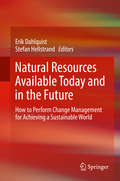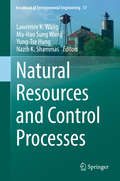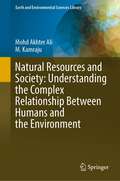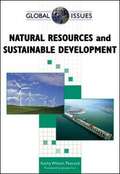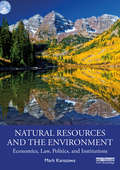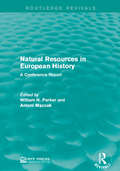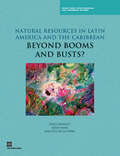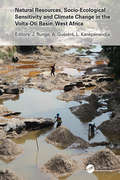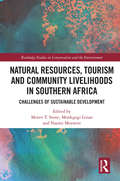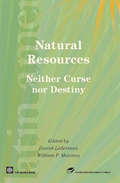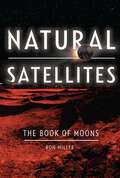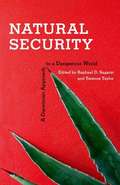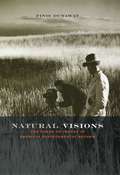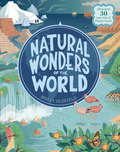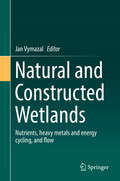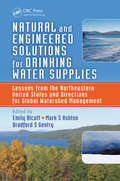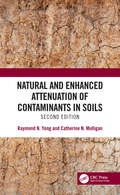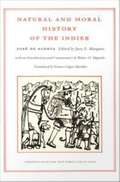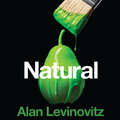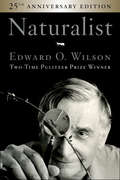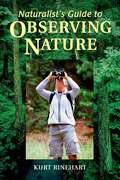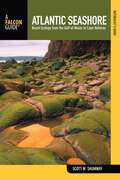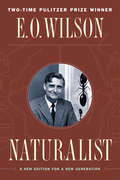- Table View
- List View
Natural Resources Available Today and in the Future
by Erik Dahlquist Stefan HellstrandThis book focuses on providing an overview of all our available natural resources, considering the sustainability and potential for power generation of each. Energy efficiency prospects of each natural resource are examined in the context of society's key energy needs- Heating/cooling, Electric Power, Transportation and Industrial Production. Geography, climate and demographics are all discussed as key vectors impacting the comparative opportunities for self-sustenance around the globe. The authors provide in-depth coverage of renewable energy upscale and energy efficiency improvements in industry and society within a historical context, including a keen look at the variable effectiveness of different policy tools that have been used to support the transition away from unsustainable resource use. Finally, suggestions for more sustainable futures are provided, from improved policy measures, to new technological horizons in areas from offshore wind and marine energy to biogas and energy storage.
Natural Resources and Control Processes
by Lawrence K. Wang Yung-Tse Hung Nazih K. Shammas Mu-Hao Sung WangThis edited book has been designed to serve as a natural resources engineering reference book as well as a supplemental textbook. This volume is part of the Handbook of Environmental Engineering series, an incredible collection of methodologies that study the effects of pollution and waste in their three basic forms: gas, solid, and liquid. It complements two other books in the series including Environmental and Natural Resources Engineering and Integrated Natural Resources Management that serve as a basis for advanced study or specialized investigation of the theory and analysis of various natural resources systems. This book covers the management of many waste sources including those from agricultural livestock, deep-wells, industries manufacturing dyes, and municipal solid waste incinerators. The purpose of this book is to thoroughly prepare the reader for understanding the sources, treatment and control methods of toxic wastes shown to have harmful effects on the environment. Chapters provide information on some of the most innovative and ground-breaking advances in waste characterization, control, treatment and management from a panel of esteemed experts.
Natural Resources and Public Property Under the Canadian Constitution (The Royal Society of Canada Special Publications)
by Gerard La ForestThe controversy aroused by the Supreme Court's decision on offshore mineral rights emphsizes the importance of the public domain in the workings of the Canadian constitution. Public property is important to the provinces not only for its revenues, but also because it provides them with a powerful instrument for control of their economic and political destinies and strengthens their position in relation to federal authorities. The provisions of the British North America Act and other constitutional instruments relating to natural resources and public property are examined thoroughly in this series of lectures given to doctoral systems at the Faulte de droit of the Universite de Montreal. Professor La Forest studies ownership of mines and minerals, navigable waters, public harbours, fisheries and Indian lands, as well as the currently controversial offshore mineral rights. He notes the political imlications of the partition of proprietary rights and explores the areas of conflict between the federal and provincial governments. Also included is a discussion of the power of expropriation, and, because public property involves public monies, lending and spending powers receive attention.In these lectures, Professor La Forest traces public domain in Britain from the time when the monarch controlled all the land, to his surrender of this control to parliament in return for a civil list, and to the similar surrender to the legislatures of the British North American colonies in connection with the struggle of responsible government.The collection of lectures is essential reading for any serious student of the constitution and will be very useful to all who are interested in the increasingly important law of natural resources in Canada.
Natural Resources and Society: Understanding the Complex Relationship Between Humans and the Environment (Earth and Environmental Sciences Library)
by Mohd Akhter Ali M. Kamraju"Natural Resources and Society: Understanding the Complex Relationship Between Humans and the Environment" is a study of the dynamic interplay between humans and the natural world. The book explores the complex relationship between human societies and the environment, examining how human actions can both impact and be influenced by natural resources.The book covers a broad range of topics, including the history of human resource use, the role of natural resources in economic development, and the environmental impacts of resource extraction and consumption. It also considers the social and cultural factors that shape human interactions with the natural world, and the challenges of sustainable resource management. Overall, the book provides a comprehensive overview of the relationship between humans and the environment, emphasizing the importance of understanding this relationship in order to develop more sustainable and equitable societies.
Natural Resources and Sustainable Development
by Kathy Wilson PeacockJeremy Carl (Program on Energy and Sustainable Development, Stanford U.) introduces this volume by noting that whether development is viewed as more or less sustainable depends on how "sustainable development" is defined. Peacock (a generalist writer/ editor) presents a balanced introduction to this pivotal contemporary environmental, political, and social concept. Starting with factors contributing to the devastation of New Orleans by Hurricane Katrina, she examines issues of urbanization, over- consumption, and overpopulation from US and global perspectives. Written specifically with high school students in mind, the volume includes source documents, an annotated bibliography, chronology from prehistory to the near future, and a glossary. Annotation ©2008 Book News, Inc., Portland, OR (booknews.com)
Natural Resources and the Environment: Economics, Law, Politics, and Institutions
by Mark KanazawaNatural Resources and the Environment: Economics, Law, Politics, and Institutions provides a new approach to the study of environmental and natural resource economics. It augments current contributions from the fields of public choice, law, and economics, and the burgeoning field of what used to be called the "New Institutional Economics," to describe, explain, and interpret how these new developments have been applied to better understand the economics of natural resources and the environment. This textbook takes a multi-disciplinary approach, which is essential for understanding complex environmental problems, and examines the issue from not only an economic perspective, but also taking into account law, politics, and institutions. In doing so, it provides students with a realistic understanding of how environmental policy is created and presents a comprehensive examination of real-world environmental policy. The book provides a comprehensive coverage of key issues, including renewable energy, climate change, agriculture, water resources, land conservation, and fisheries, with each chapter accompanied by learning resources, such as recommended further reading, discussion questions, and exercises. This textbook is essential reading for students and scholars seeking to build an interdisciplinary understanding of natural resources and the environment.
Natural Resources in European History: A Conference Report (Routledge Revivals)
by Antoni Mączak and William N. ParkerNatural Resources in European History pulls together several papers from the Bellagio Conference on Natural Resources and Economic Development which took place in 1977. Originally published in 1978, this report focuses on papers exploring the history of natural resources in Continental Europe presenting research on how resources were traded, collected and depleted between the fifteenth and nineteenth century. This title will be of interest to students of Environmental Studies or with an interest in Environmental History.
Natural Resources in Latin America and the Caribbean: Beyond Booms and Busts?
by John Nash Augusto De la Torre Emily SinnottPolicy makers in many countries in the Latin American and Caribbean region have found it challenging to determine how to treat natural resource commodity production and how to manage the recurrent cycles of booms and busts. 'Natural Resources in Latin America and the Caribbean: Beyond Booms and Busts?' addresses the major concerns associated with commodity dependence, summarizing the state of the art in existing literature and filling in the knowledge gaps with new analysis. The report finds that some commonly accepted negative effects of dependence on natural resources are largely myths, while some are realities. But the authors find that all the effects can be managed, and they provide practical advice on how to do so. Issues covered include long-term fiscal growth, fiscal volatility, institutional impacts, and environmental and social effects. The report analyzes the implications for the region's development and policies. 'Natural Resources in Latin America and the Caribbean: Beyond Booms and Busts?' will be of interest to policy makers, academics, and analysts, as well as others interested in the economics of commodity markets and their role in economic development.
Natural Resources, Socio-Ecological Sensitivity and Climate Change in the Volta-Oti Basin, West Africa
by Jürgen RungeThis book presents the outcome of an interdisciplinary and international workshop supported by the Volkswagen Stiftung (funding line ‘Knowledge for Tomorrow’) on the topic of ‘Natural Resources, Socio-Ecological Sensitivity and Climate Change in the Volta-Oti Basin, West Africa’. The conference was jointly organised by Goethe-University Frankfurt (Germany) and the University of Kara (Togo) held from March 6 to 8, 2019 in northern Togo. It aimed to strengthen capacities of junior scientists from the sub-region, exchange and mobilise theoretical and methodological background from various scientific fields (Botany, Construction, Geology, Geography, Infrastructure, Politics, Remote Sensing, Sociology and Urban Planning). One goal was to deliver reliable elements for ongoing and profound environmental analyses that lie outside the common questions of the academic and civil society stakeholders. Ecosystem fragmentation and deforestation in West Africa are mainly triggered by humans such as agriculture and small-scale forest disturbances for charcoal and firewood production. Increasing population pressure, declining of carrying capacity and demand for agricultural land caused the reduction of land conservation capacities, even in protected areas. The complexity of interactions between environmental and socio-ecological systems and subsequent effects (sensitivity) has raised ongoing international awareness in light of ongoing climate change. By the example of natural resources, land use and stakeholders’ perceptions within the Volta-Oti Basin the book’s proceedings present, discuss and distribute new findings that will sustainably stimulate the international debate. The workshop also intended to overcome national borders and language barriers between the Anglophone (Ghana) and the Francophone (Benin, Burkina Faso, Ivory Coast, Togo) research communities, and supported better West African cooperation and networking. The young as well as the established partners formed new collaborations, and the event at the University of Kara (Togo) was a truly unique opportunity for all involved, not only to discuss science, but also to assess applied and best future management practices for the Oti-Volta Basin in West Africa.
Natural Resources, Tourism and Community Livelihoods in Southern Africa: Challenges of Sustainable Development (Routledge Studies in Conservation and the Environment)
by Naomi Moswete Moren T. Stone Monkgogi LenaoThis book examines the connections between natural resources, tourism and community livelihood practices in Southern Africa, highlighting the successes and constraints experienced over the last 50 years. Questioning how natural resources, tourism and community livelihoods relations can positively contribute towards development efforts, this book adopts an interdisciplinary approach to understand socio-ecological systems that characterize the dynamics for sustainable development. It explores the history of conservation and natural resource management in Southern Africa and traces the development and growth of nature-based tourism. Boasting a wide range of tourism landscapes, including national parks, wetlands, forests and oceans, the book draws on case studies from a variety of Southern African countries, including Botswana, Namibia and South Africa, and considers the political challenges for implementing policies and practices. Furthermore, it analyses broader issues such as the impact of climate change, human–wildlife co-existence and resulting conflicts, poor access to funding and poverty in local communities. The book argues that the links between conservation and livelihoods can be best understood by considering the different approaches to reconciling the demands of conservation and livelihoods that have evolved over the past decades. Containing contributions from natural and social sciences the book provides guidance for practitioners and policymakers to continue to shape policies and practices that are in line with the key tenets of sustainable development. It will also be of great interest to students and scholars researching Southern Africa, sustainable tourism and conservation.
Natural Resources: Neither Curse nor Destiny
by Daniel Lederman William F. Maloney'Natural Resources: Neither Course nor Destiny' brings together a variety of analytical perspectives, ranging from econometric analyses of economic growth to historical studies of successful development experiences in countries with abundant natural resources. The evidence suggests that natural resources are neither a curse nor destiny. Natural resources can actually spur economic development when combined with the accumulation of knowledge for economic innovation. Furthermore, natural resource abundance need not be the only determinant of the structure of trade in developing countries. In fact, the accumulation of knowledge, infrastructure, and the quality of governance all seem to determine not only what countries produce and export, but also how firms and workers produce any good.
Natural Rivals: John Muir, Gifford Pinchot, And The Creation Of America's Wilderness
by John ClaytonA dynamic examination that traces the lives of two of the most influential figures—and their dueling approaches—on America's natural landscape. John Muir, the most famous naturalist in American history, protected Yosemite, co-founded the Sierra Club, and is sometimes called the Father of the National Parks. A poor immigrant, self-taught, individualistic, and skeptical of institutions, his idealistic belief in the spiritual benefits of holistic natural systems led him to a philosophy of preserving wilderness unimpaired. Gifford Pinchot founded the U.S. Forest Service and advised his friend Theodore Roosevelt on environmental policy. Raised in wealth, educated in privilege, and interested in how institutions and community can overcome failures in individual virtue, Pinchot’s pragmatic belief in professional management led him to a philosophy of sustainably conserving natural resources. When these rivaling perspectives meet, what happens? For decades, the story of their relationship has been told as a split between the conservation and preservation philosophies, sparked by a proposal to dam a remote Yosemite valley called Hetch Hetchy. But a decade before that argument, Muir and Pinchot camped together alongside Montana’s jewel-like Lake McDonald in, which was at the heart of a region not yet consecrated as Glacier National Park. At stake in 1896 was the new idea that some landscapes should be collectively, permanently owned by a democratic government. Although many people today think of public lands as an American birthright, their very existence was then in doubt, and dependent on a merger of the talents of these two men. Natural Rivals examines a time of environmental threat and political dysfunction not unlike our own, and reveals the complex dynamic that gave birth to America's rich public lands legacy.
Natural Satellites: The Book of Moons
by Ron MillerFor centuries, astronomers have placed a special importance on the other planets of the solar system. But with the advent of spacecraft and the tremendous missions undertaken by the Voyager and Cassini probes, astronomers have discovered that the natural satellites of the planets—the solar system's moons—are some of the most extraordinary places imaginable. There are moons with towering geysers, erupting volcanoes, and subterranean oceans of warm, mineral-rich water. Some of the highest mountains and deepest canyons can be found on moons. There are moons that have shattered into pieces and then reassembled. There is even a moon where it rains rocket fuel. Recently, scientists have turned to moons for answers in their investigations of the origins of the solar system and the evolution of life on our own planet. Featuring full-color, scientifically accurate illustrations by NASA artist Ron Miller, Natural Satellites: The Book of Moons chronicles these investigations and the questions we have yet to answer in our exploration of the solar system's moons.
Natural Security: A Darwinian Approach to a Dangerous World
by Raphael D. Sagarin Terence TaylorThe post 9/11 world has so far failed to exploit the insights of the greatest experiment in security of all time--the millions of successful defensive and offensive security strategies that abound in nature. Arms races among invertebrates, intelligence gathering by the immune system, alarm calls by marmots are but a few of nature's security strategies that have been tested and modified over billions of years. This provocative book applies lessons from nature to our own toughest security problems-from global terrorism to the rise of infectious disease to natural disasters. Written by a truly multi-disciplinary group including paleobiologists, anthropologists, psychologists, ecologists, and national security experts, it considers how models and ideas from evolutionary biology can improve national security strategies ranging from risk assessment, security analysis, and public policy to long-term strategic goals. Written with the aim of breaking down barriers between disparate disciplines in order to create more responsive and effective strategies,Natural Security provides a new lens through which to explore the ancient and ever present problem of how to maintain security in an unpredictable, complex, and dangerous world.
Natural Visions: The Power of Images in American Environmental Reform
by Finis DunawayWalden Pond. The Grand Canyon.Yosemite National Park. Throughout the twentieth century, photographers and filmmakers created unforgettable images of these and other American natural treasures. Many of these images, including the work of Ansel Adams, continue to occupy a prominent place in the American imagination. Making these representations, though, was more than a purely aesthetic project. In fact, portraying majestic scenes and threatened places galvanized concern for the environment and its protection. Natural Visions documents through images the history of environmental reform from the Progressive era to the first Earth Day celebration in 1970, showing the crucial role the camera played in the development of the conservation movement. In Natural Visions, Finis Dunaway tells the story of how visual imagery—such as wilderness photographs, New Deal documentary films, and Sierra Club coffee-table books—shaped modern perceptions of the natural world. By examining the relationship between the camera and environmental politics through detailed studies of key artists and activists, Dunaway captures the emotional and spiritual meaning that became associated with the American landscape. Throughout the book, he reveals how photographers and filmmakers adapted longstanding traditions in American culture—the Puritan jeremiad, the romantic sublime, and the frontier myth—to literally picture nature as a place of grace for the individual and the nation. Beautifully illustrated with photographs by Ansel Adams, Eliot Porter, and a host of other artists, Natural Visions will appeal to a wide range of readers interested in American cultural history, the visual arts, and environmentalism.
Natural Wonders of the World: Discover 30 marvels of Planet Earth
by Molly OldfieldSet off on a journey of discovery in this beautiful photographic celebration of the natural world.From firefly squid glowing against the night sky in Japan to a Mexican cave filled with the largest crystals ever found, you'll discover the stories and science behind these wonders, the threats they now face and the efforts taking place to save them. How did the Grand Canyon come to be? Where is the most electric place on Earth? And what can we do to protect the Great Barrier Reef?Both a stunning tour of the planet we call home, and an overview of some of the biggest environmental problems of today, Natural Wonders of the World is the perfect gift for anyone who loves exploring the great outdoors.
Natural and Constructed Wetlands
by Jan VymazalThe book extends the knowledge on wetland ecosystem services based on the new research. The information combines the achievements gained in carbon sequestration, nutrient accumulation, macrophyte decomposition, wastewater treatment, global warming mitigation in constructed as well as natural wetlands across the globe. The book presents up-to-date results of ongoing research and the content of the book could be used by wetland scientists, researchers, engineers, designers, regulators, decision-makers, universities teachers, landscape engineers and landscape planners as well as by water authorities, water regulatory offices or wastewater treatment research institutions.
Natural and Engineered Solutions for Drinking Water Supplies: Lessons from the Northeastern United States and Directions for Global Watershed Management
by Mark S. Ashton Emily Alcott Bradford S. GentryIlluminating opportunities to develop a more integrated approach to municipal water system design, Natural and Engineered Solutions for Drinking Water Supplies: Lessons from the Northeastern United States and Directions for Global Watershed Management explores critical factors in the decision-making processes for municipal water system delivery. Th
Natural and Enhanced Attenuation of Contaminants in Soils, Second Edition
by Raymond N. Yong Catherine N. MulliganNatural attenuation has become an effective and low-cost alternative to more expensive engineered remediation. This new edition updates the principles and fundamentals of natural attenuation of contaminants with a broader view of the field. It includes new methods for evaluating natural attenuation mechanisms and microbial activity at the lab and field scales. Case studies, actual treatments and protocols, theoretical processes, case studies, numerical models, and legal aspects in the natural attenuation of organic and inorganic contaminants are examined. Challenges and future directions for the implementation of natural attenuation and enhanced remediation techniques are also considered.
Natural and Moral History of the Indies
by José De AcostaThe Natural and Moral History of the Indies, the classic work of New World history originally published by José de Acosta in 1590, is now available in the first new English translation to appear in several hundred years. A Spanish Jesuit, Acosta produced this account by drawing on his own observations as a missionary in Peru and Mexico, as well as from the writings of other missionaries, naturalists, and soldiers who explored the region during the sixteenth century. One of the first comprehensive investigations of the New World, Acosta's study is strikingly broad in scope. He describes the region's natural resources, flora and fauna, and terrain. He also writes in detail about the Amerindians and their religious and political practices. A significant contribution to Renaissance Europe's thinking about the New World, Acosta's Natural and Moral History of the Indies reveals an effort to incorporate new information into a Christian, Renaissance worldview. He attempted to confirm for his European readers that a "new" continent did indeed exist and that human beings could and did live in equatorial climates. A keen observer and prescient thinker, Acosta hypothesized that Latin America's indigenous peoples migrated to the region from Asia, an idea put forth more than a century before Europeans learned of the Bering Strait. Acosta's work established a hierarchical classification of Amerindian peoples and thus contributed to what today is understood as the colonial difference in Renaissance European thinking.
Natural: The Seductive Myth of Nature's Goodness
by Alan LevinovitzWithout our realising it, a single, slippery concept has become a secular deity throughout the modern industrial world. We make terrible sacrifices in its name: of our money, our health, and our planet. That deity is nature itself.From supermarket shoppers to evolutionary biologists, from atheists to pastors, from Alex Jones to Gwyneth Paltrow, we are all prone to the intuitive faith that life should be lived 'naturally'.But nature can't teach us how to live. If we try to stick to its imagined commands, eschewing human artifice in pursuit of Edenic purity, we jeopardise the environment, our health, and our society. (We also waste a lot of money on pots of weird slime). It is time to accept our profound responsibility to shape the world of which our technologyand our selves are wholly a part.
Naturalist 25th Anniversary Edition
by Edward O. WilsonEdward O. Wilson – University Professor at Harvard, winner of two Pulitzer prizes, eloquent champion of biodiversity – is arguably one of the most important thinkers of the twentieth century. His career represents both a blueprint and a challenge to those who seek to explore the frontiers of scientific understanding. Yet, until now, little has been told of his life and of the important events that have shaped his thought.In Naturalist, Wilson describes for the first time both his growth as a scientist and the evolution of the science he has helped define. He traces the trajectory of his life – from a childhood spent exploring the Gulf Coast of Alabama and Florida to life as a tenured professor at Harvard – detailing how his youthful fascination with nature blossomed into a lifelong calling. He recounts with drama and wit the adventures of his days as a student at the University of Alabama and his four decades at Harvard University, where he has achieved renown as both teacher and researcher.As the narrative of Wilson's life unfolds, the reader is treated to an inside look at the origin and development of ideas that guide today's biological research. Theories that are now widely accepted in the scientific world were once untested hypotheses emerging from one man's broad-gauged studies. Throughout Naturalist, we see Wilson's mind and energies constantly striving to help establish many of the central principles of the field of evolutionary biology.The story of Wilson's life provides fascinating insights into the making of a scientist, and a valuable look at some of the most thought-provoking ideas of our time.
Naturalist's Guide to Observing Nature
by Kurt RinehartAn innovative guide to making the most of the wilderness experience.
Naturalist's Guide to the Atlantic Seashore: Beach Ecology From The Gulf Of Maine To Cape Hatteras (Naturalist's Guide Series)
by Scott ShumwayFrom the North Carolina's Outer Banks to Maine's rocky coast, this comprehensive guidebook covers the ecology, wildlife, plants and ocean creatures in full-color photographs and vivid detail. No other book includes all of the plants, animals, and terrain along this stretch of coastline, making this a must-have for anyone who lives or recreates near the Atlantic. The diverse habitats of the seashore, from the Rocky Shores to Sandy Beaches, Estuaries, Tidal Flats, Salt Marshes, Seagrass Meadows, and the Open Ocean are explored in detail in this user-friendly guide and natural history. The easy-to-use layout, comprehensive index, water-resistant cover and guaranteed binding make this a beautiful volume of natural history and biodiversity.Scott W. Shumway is a professor of biology at Wheaton College. He lives in Westborough, Massachusetts.
Naturalist: Conservation And Development In The Maya Forest Of Belize (Naturalist Directory And Almanac Ser.)
by Edward O. WilsonEdward O. Wilson -- University Professor at Harvard, winner of two Pulitzer prizes, eloquent champion of biodiversity -- is arguably one of the most important thinkers of the twentieth century. His career represents both a blueprint and a challenge to those who seek to explore the frontiers of scientific understanding. Yet, until now, little has been told of his life and of the important events that have shaped his thought.In Naturalist, Wilson describes for the first time both his growth as a scientist and the evolution of the science he has helped define. He traces the trajectory of his life -- from a childhood spent exploring the Gulf Coast of Alabama and Florida to life as a tenured professor at Harvard -- detailing how his youthful fascination with nature blossomed into a lifelong calling. He recounts with drama and wit the adventures of his days as a student at the University of Alabama and his four decades at Harvard University, where he has achieved renown as both teacher and researcher.As the narrative of Wilson's life unfolds, the reader is treated to an inside look at the origin and development of ideas that guide today's biological research. Theories that are now widely accepted in the scientific world were once untested hypotheses emerging from one mans's broad-gauged studies. Throughout Naturalist, we see Wilson's mind and energies constantly striving to help establish many of the central principles of the field of evolutionary biology.The story of Wilson's life provides fascinating insights into the making of a scientist, and a valuable look at some of the most thought-provoking ideas of our time.
